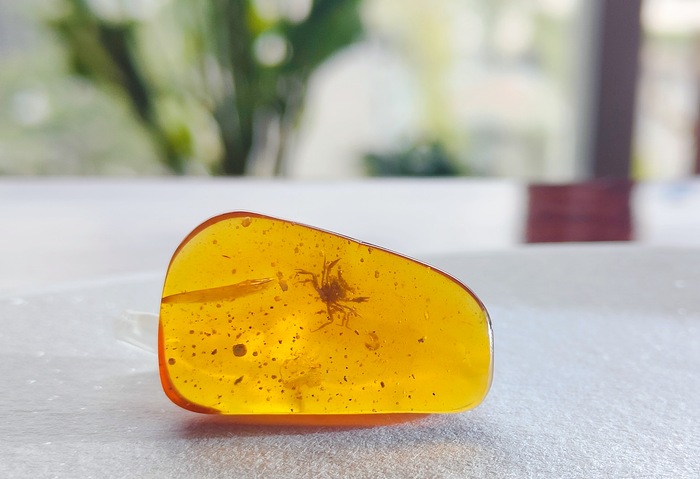During the dinosaur era, a crab wandering near a coastal forest was buried alive in tree resin and became fossilized. 100 million years later, Javier Luque, a former predoctoral fellow at the Smithsonian Tropical Research Institute and currently a Research Associate at Harvard University, became aware of the crustacean trapped in amber thanks to Lida Xing from the China University of Geosciences, Beijing.* It turned out to be a new fossil species, which they named Cretapsara athanata or “the immortal Cretaceous spirit of the clouds and waters,” the oldest modern-looking crab ever discovered.

Credit: Lida Xing (China University of Geosciences, Beijing)
During the dinosaur era, a crab wandering near a coastal forest was buried alive in tree resin and became fossilized. 100 million years later, Javier Luque, a former predoctoral fellow at the Smithsonian Tropical Research Institute and currently a Research Associate at Harvard University, became aware of the crustacean trapped in amber thanks to Lida Xing from the China University of Geosciences, Beijing.* It turned out to be a new fossil species, which they named Cretapsara athanata or “the immortal Cretaceous spirit of the clouds and waters,” the oldest modern-looking crab ever discovered.
The discovery of C. athanata is unique for many reasons. Not only is it extremely well conserved, but also it is the first crab from the dinosaur era preserved in amber, which is rare for aquatic animals. These findings were recently published in the journal Science Advances.
“Cretapsara athanata is the most complete fossil crab ever discovered,” said Luque, co-lead author of the study along with Xing. “It includes delicate tissues like antennae, mouthparts lined with fine hairs, large compound eyes, and even the gills.”
Previous fossil records of crabs—mainly bits and pieces of their carapaces or claws—, suggested that crabs ventured onto land and adapted to freshwater about 75 to 50 million years ago. However, to become trapped in amber, C. athanata must have been near an amber-producing forest. For the authors it appears that the crab most likely died in a brackish or freshwater environment near the coast or an estuary. This demonstrates that crabs became terrestrial or amphibious about 100 million years ago—much earlier than previously thought—bridging an important gap in understanding crab evolution.
“Sometimes it is difficult to piece together the tree of life that maps the evolution of the animals seen today,” said Luque. “Important pieces in the puzzle may be rare or yet to be discovered, and fossils trapped in amber provide a unique snapshot of the anatomy, biology, and ecology of extinct organisms that would be otherwise inaccessible.”
###
* Disclaimer:
The fossil crab in amber studied is housed in the Longyin Amber Museum (LYAM), Kunming, Yunnan Province, China. It comes from a batch of commercial ‘raw’ amber pieces collected by local miners and sold to a vendor at an amber jewelry market in Myitkyina on May 12, 2015. LYAM acquired the polished piece containing the fossil from the vendor’s mineral store in Tengchong, China, on August 10, 2015. We acknowledge the existence of a sociopolitical conflict in northern Myanmar and have limited our research to material predating the 2017 resumption of hostilities in the region. We hope that conducting research on specimens collected before the conflict, and acknowledging the situation in the Kachin State, will serve to raise awareness of the current conflict in Myanmar and the human cost behind it.
The Smithsonian Tropical Research Institute, headquartered in Panama City, Panama, is part of the Smithsonian Institution. The Institute furthers the understanding of tropical nature and its importance to human welfare, trains students to conduct research in the tropics and promotes conservation by increasing public awareness of the beauty and importance of tropical ecosystems.
Journal
Science Advances
DOI
10.1126/sciadv.abj5689
Article Title
Crab in amber reveals an early colonization of nonmarine environments during the Cretaceous
Article Publication Date
20-Oct-2021




